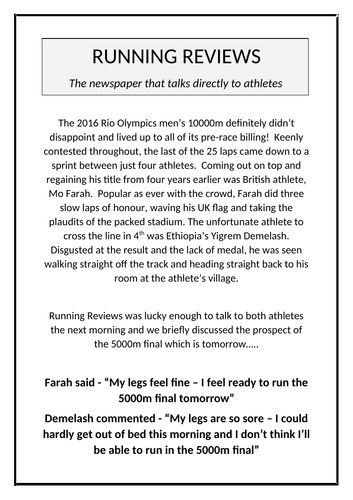



A fully- resourced lesson which looks at the chemical reaction that is anaerobic respiration and ensures that students can understand why this form of respiration can only be used for short periods of time. The lesson includes an engaging lesson presentation (39 slides), a newspaper article and application questions.
The lesson begins by challenging the students to recall information about aerobic respiration to recognise that the sole reactant of anaerobic respiration is glucose. A newspaper article about two atheletes from the 10000m race has been written to challenge the students to recognise why one of the athletes wouldnt be able to compete again in the near future whilst the other could. As a result, students will be introduced to lactic acid and will learn how this poisonous substance prevents muscle contraction and causes cramps. Time is taken to ensure that students are familiar with ATP and specifically that they recognise that a much lower yield is produced in this type of respiration. A perfect opportunity is taken to get the students to carry out a mathematical calculation to compare the yields. Oxygen debt is discussed and related back to the original newspaper article. Finally, anaerobic respiration in plants and yeast is considered in terms of fermentation and the word and symbol equation is written so that it can be compared to those from animals.
There are regular progress checks throughout the lesson to allow the students to check on their understanding. The lesson has been written for GCSE students but could be used with higher ability KS3 students or A-level students who want a recap before covering the topic in greater detail on their course.
Get this resource as part of a bundle and save up to 33%
A bundle is a package of resources grouped together to teach a particular topic, or a series of lessons, in one place.
Topic B1: Cell-level systems (OCR Gateway A GCSE Biology)
This bundle of 10 lessons covers the majority of the content in Topic B1 (Cell-level systems) of the OCR Gateway A GCSE Biology specification. The topics covered within these lessons include: Plant and animal cells Bacterial cells Light microscopy Electron microscopy DNA Transcription and translation Enzymes Enzyme actions Aerobic respiration Anaerobic respiration Photosynthesis Limiting factors All of these lesson presentations and accompanying resources are detailed and engaging and contain regular progress checks to allow the students to constantly assess their understanding.
Topic B1: Cell Level Systems (OCR Gateway A GCSE Combined Science)
This bundle of 9 lessons covers the majority of the content in Topic B1 of the OCR Gateway A GCSE Combined Science specification. The topics covered within these lessons include: Animal and plant cells Prokaryotic cells Light and electron microscopy DNA Enzymes Enzyme activity Aerobic respiration Anaerobic respiration Photosynthesis All of these lesson presentations and accompanying resources are detailed and engaging and contain regular progress checks to allow the students to constantly assess their understanding. It is estimated that this bundle would cover about 6 week's worth of lessons.
Topic B4: Bioenergetics (AQA Trilogy GCSE Combined Science & GCSE Biology)
This bundle of 4 lessons covers the majority of the content in Topic B4 (Bioenergetics) of the AQA Trilogy GCSE Combined Science & GCSE Biology specifications. The topics covered within these lessons include: Photosynthesis Uses of glucose from photosynthesis Limiting factors Aerobic respiration Anaerobic respiration Response to exercise All of these lesson presentations and accompanying resources are detailed and engaging and contain regular progress checks to allow the students to constantly assess their understanding.
Topic B8: Exchange and transport in animals (Edexcel GCSE Combined Science)
This bundle of 7 lessons covers the majority of the content in Topic B8 (Exchange and transport in animals) of the Edexcel GCSE Combined Science specification. The topics covered within these lessons include: The need to transport substances Surface to volume ratio Gas exchange at the alveoli The structure of blood and its function The structure of blood vessels The structure of the heart Aerobic and anaerobic respiration All of these lesson presentations and accompanying resources are detailed and engaging and contain regular progress checks to allow the students to constantly assess their understanding.
Something went wrong, please try again later.
This resource hasn't been reviewed yet
To ensure quality for our reviews, only customers who have purchased this resource can review it
Report this resourceto let us know if it violates our terms and conditions.
Our customer service team will review your report and will be in touch.